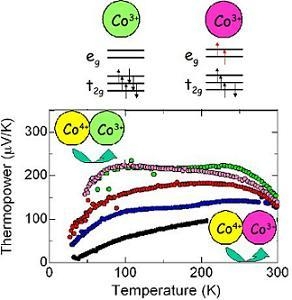Spin State Control of the Perovskite Rh/Co Oxides
Abstract
:1. Introduction
2. Results and Discussion
2.1. Thermopower in correlated systems
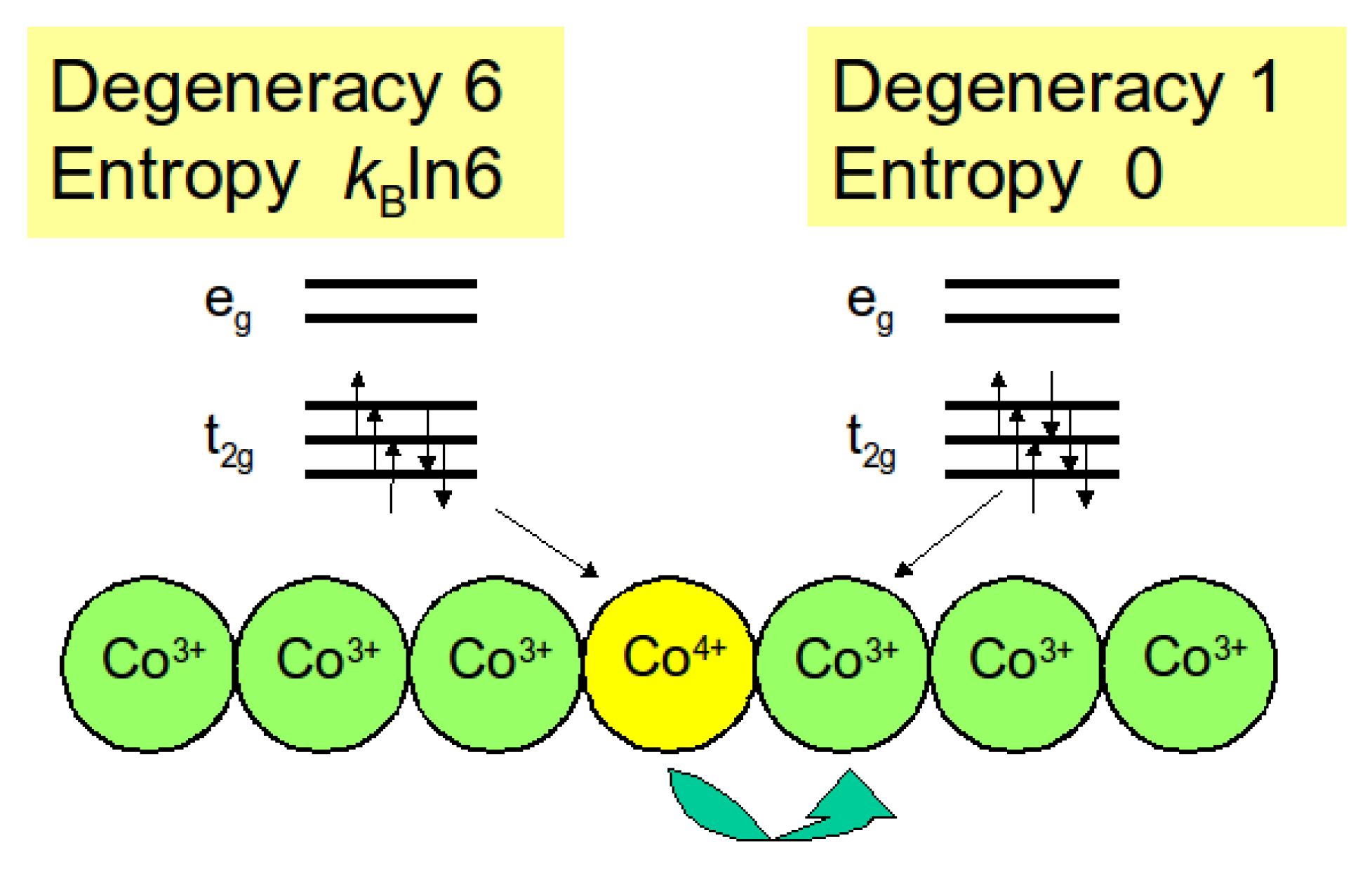
2.2. The A-site ordered perovskite cobalt oxide
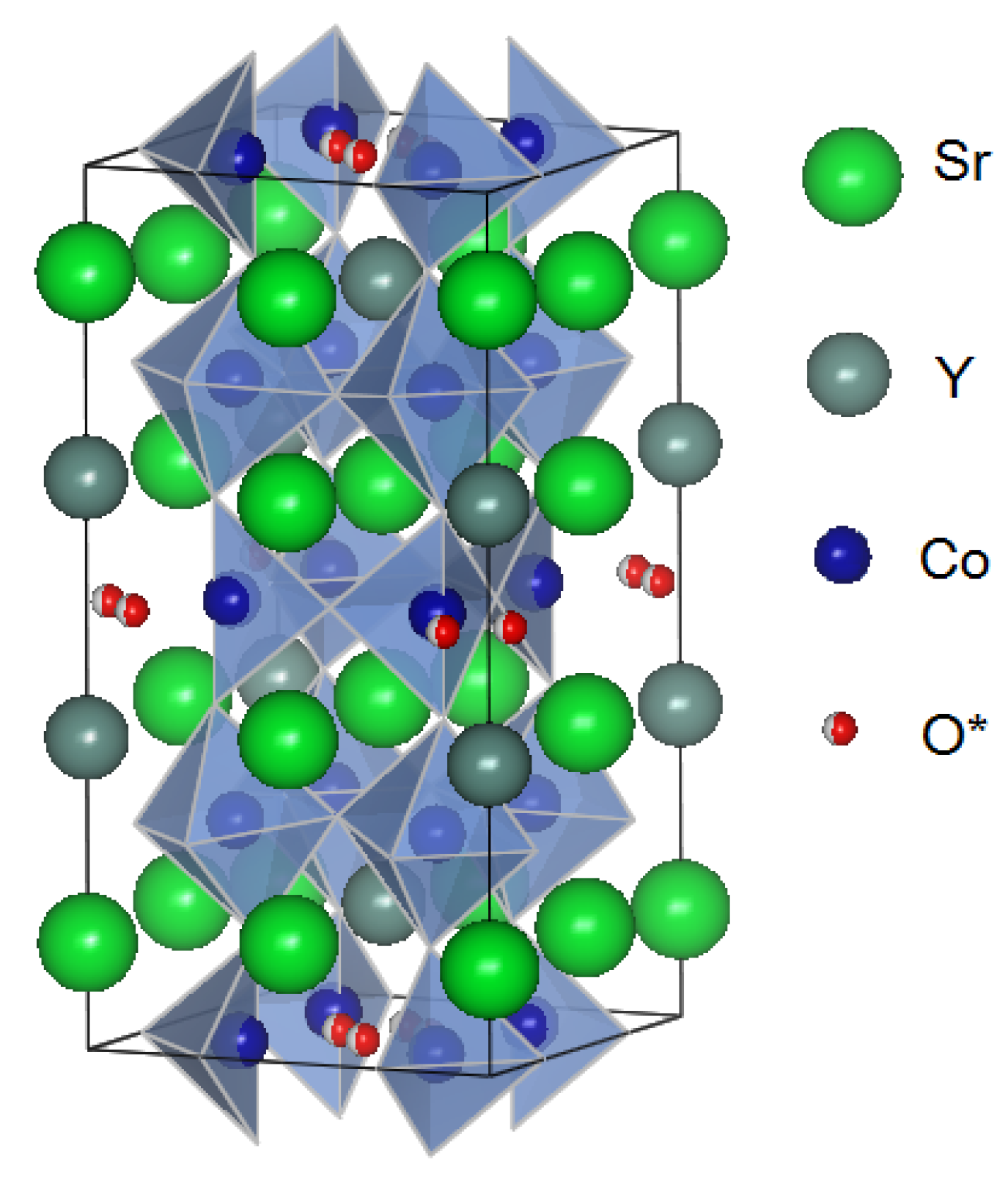
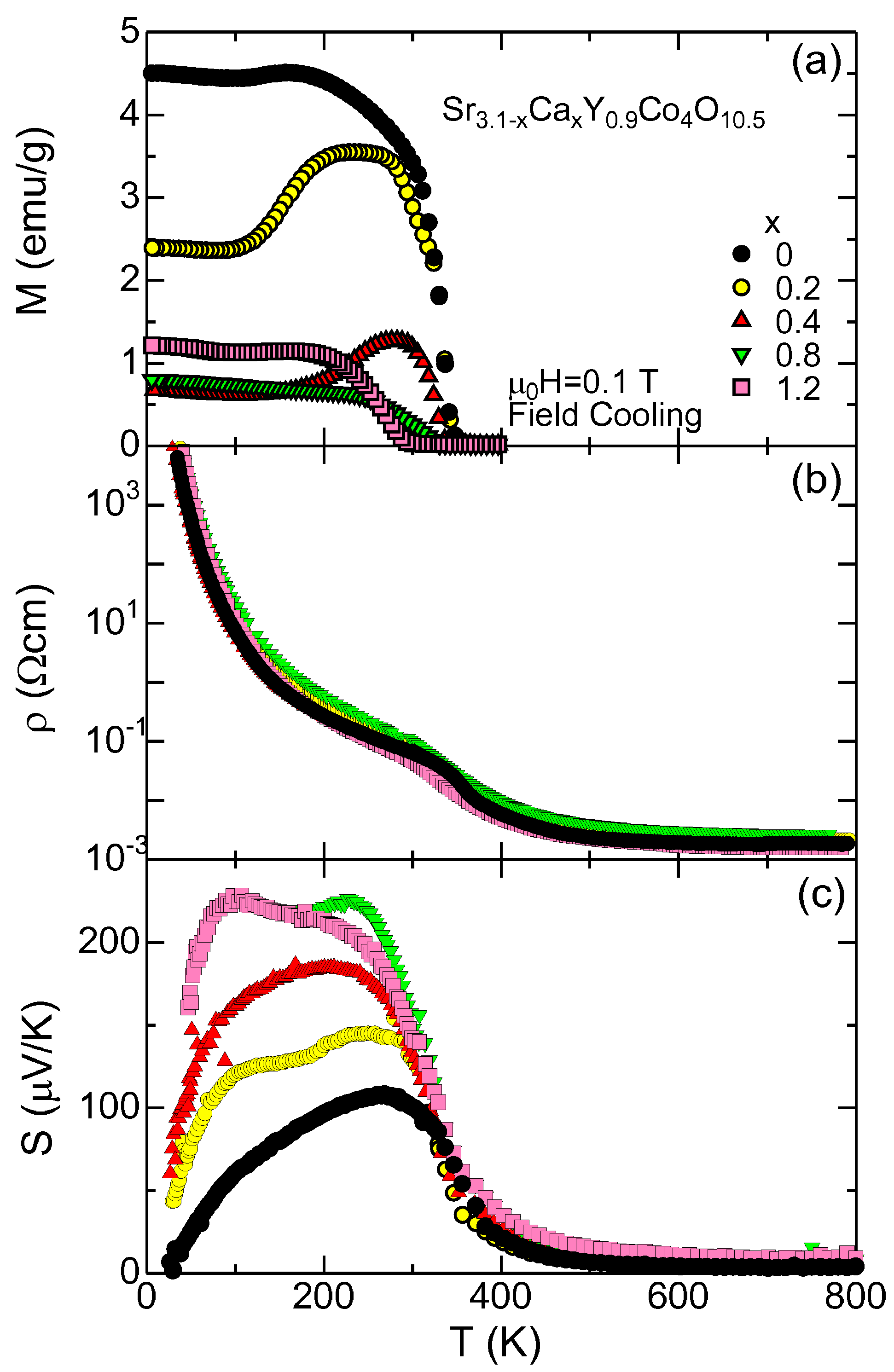
2.3. Perovskite rhodium oxide
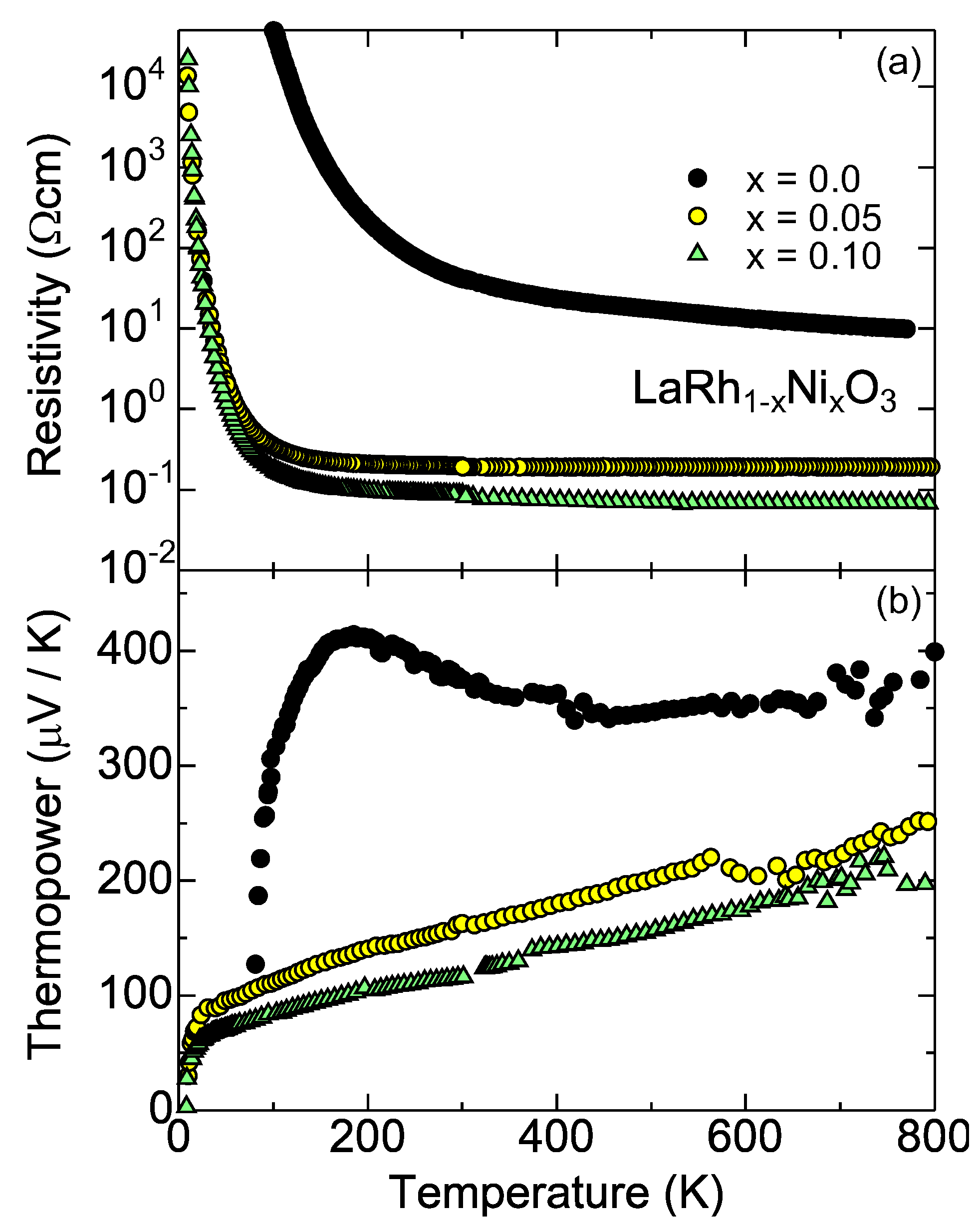

3. Experimental Section
4. Summary
Acknowledgements
References
- Sugano, S.; Tanabe, Y.; Kamimura, H. Multiplets of Transition-Metal Ions in Crystals; Academic Press: New York, NY, USA, 1970. [Google Scholar]
- Gütlich, P.; Garcia, Y.; Goodwin, H.A. Spin crossover phenomena in Fe(II) complexes. Chem. Soc. Rev. 2000, 29, 419–427. [Google Scholar] [CrossRef]
- Raccah, P.M.; Goodenough, J.B. First-order localized-electron collective-electron transition in LaCoO3. Phys. Rev. 1967, 155, 932–943. [Google Scholar] [CrossRef]
- Asai, K.; Yoneda, A.; Yokokura, O.; Tranquada, J.M.; Shirane, G.; Kohn, K. Two spin-state transitions in LaCoO3. J. Phys. Soc. Jpn. 1998, 67, 290–296. [Google Scholar] [CrossRef]
- Vogt, T.; Hriljac, J.A.; Hyatt, N.C.; Woodward, P. Pressure-induced intermediate-to-low spin state transition in LaCoO3. Phys. Rev. B 2003, 67, 140401. [Google Scholar] [CrossRef]
- Korotin, M.A.; Ezhov, S.Y.; Solovyev, I.V.; Anisimov, V.I.; Khomskii, D.I.; Sawatzky, G.A. Intermediate-spin state and properties of LaCoO3. Phys. Rev. B 1996, 54, 5309–5316. [Google Scholar] [CrossRef]
- Noguchi, S.; Kawamata, S.; Okuda, K.; Nojiri, H.; Motokawa, M. Evidence for the excited triplet of Co3+ in LaCoO3. Phys. Rev. B 2002, 66, 094404. [Google Scholar] [CrossRef]
- Maris, G.; Ren, Y.; Volotchaev, V.; Zobel, C.; Lorenz, T.; Palstra, T.T.M. Evidence for orbital ordering in LaCoO3. Phys. Rev. B 2003, 67, 224423. [Google Scholar] [CrossRef]
- Haverkort, M.W.; Hu, Z.; Cezar, J.C.; Burnus, T.; Hartmann, H.; Reuther, M.; Zobel, C.; Lorenz, T.; Tanaka, A.; Brookes, N.B.; Hsieh, H.H.; Lin, H.J.; Chen, C.T.; Tjeng, L.H. Spin state transition in LaCoO3 studied using soft X-ray absorption spectroscopy and magnetic circular dichroism. Phys. Rev. Lett. 2006, 97, 176405. [Google Scholar] [CrossRef] [PubMed]
- Klie, R.F.; Zheng, J.C.; Zhu, Y.; Varela, M.; Wu, J.; Leighton, C. Direct measurement of the low-temperature spin-state transition in LaCoO3. Phys. Rev. Lett. 2007, 99, 047203. [Google Scholar] [CrossRef] [PubMed]
- Terasaki, I.; Sasago, Y.; Uchinokura, K. Large thermoelectric power in NaCo2O4 single crystals. Phys. Rev. B 1997, 56, R12685–R12687. [Google Scholar] [CrossRef]
- Koumoto, K.; Terasaki, I.; Funahashi, R. Complex oxide materials for potential thermoelectric applications. MRS Bull. 2006, 31, 206–210. [Google Scholar] [CrossRef]
- Terasaki, I. Transport properties and electronic states of the thermoelectric oxide NaCo2O4. Physica B 2003, 328, 63–67. [Google Scholar] [CrossRef]
- Koshibae, W.; Tsutsui, K.; Maekawa, S. Thermopower in cobalt oxides. Phys. Rev. B 2000, 62, 6869–6872. [Google Scholar] [CrossRef]
- Callen, H.B. Thermodynamics and an Introduction to Thermostatistics, 2nd ed.; John Wiley & Sons, Inc.: Hoboken, NJ, USA, 1985. [Google Scholar]
- Chaikin, P.M.; Beni, G. Thermopower in the correlated hopping regime. Phys. Rev. B 1976, 13, 647–651. [Google Scholar] [CrossRef]
- Ray, R.; Ghoshray, A.; Ghoshray, K.; Nakamura, S. 59Co NMR studies of metallic NaCo2O4. Phys. Rev. B 1999, 59, 9454–9461. [Google Scholar] [CrossRef]
- Fujita, K.; Mochida, T.; Nakamura, K. High-temperature thermoelectric properties of NaxCoO2−δ Single Crystals. Jpn. J. Appl. Phys. 1 2001, 40, 4644–4647. [Google Scholar] [CrossRef]
- Ando, Y.; Miyamoto, N.; Segawa, K.; Kawata, T.; Terasaki, I. Specific-heat evidence for strong electron correlations in the thermoelectric material (Na,Ca)Co2O4. Phys. Rev. B 1999, 60, 10580–10583. [Google Scholar] [CrossRef]
- Masset, A.C.; Michel, C.; Maignan, A.; Hervieu, M.; Toulemonde, O.; Studer, F.; Raveau, B.; Hejtmanek, J. Misfit-layered cobaltite with an anisotropic giant magnetoresistance: Ca3Co4O9. Phys. Rev. B 2000, 62, 166–175. [Google Scholar] [CrossRef]
- Maignan, A.; Wang, L.B.; Hébert, S.; Pelloquin, D.; Raveau, B. Large thermopower in metallic misfit cobaltites. Chem. Mater. 2002, 14, 1231–1235. [Google Scholar] [CrossRef]
- Funahashi, R.; Matsubara, I.; Ikuta, H.; Takeuchi, T.; Mizutani, U.; Sodeoka, S. An oxide single crystal with high thermoelectric performance in air. Jpn. J. Appl. Phys. 2000, 39, L1127–L1129. [Google Scholar] [CrossRef]
- Funahashi, R.; Shikano, M. Bi2Sr2Co2Oy whiskers with high thermoelectric figure of merit. Appl. Phys. Lett. 2002, 81, 1459–1461. [Google Scholar] [CrossRef]
- Kobayashi, W.; Terasaki, I.; Mikami, M.; Funahashi, R. Negative thermoelectric power induced by positive carriers in CaMn3−xCuxMn4O12. J. Phys. Soc. Jpn. 2004, 73, 523–525. [Google Scholar] [CrossRef]
- Kobayashi, W.; Ishiwata, S.; Terasaki, I.; Takano, M.; Grigoraviciute, I.; Yamauchi, H.; Karppinen, M. Room-temperature ferromagnetism in Sr1−xYxCoO3−δ (0.2 ≤ x ≤ 0.25). Phys. Rev. B 2005, 72, 104408. [Google Scholar] [CrossRef]
- Istomin, S.Y.; Grins, J.; Svensson, G.; Drozhzhin, O.A.; Kozhevnikov, V.L.; Antipov, E.V.; Attfield, J.P. Crystal structure of the novel complex cobalt oxide Sr0.7Y0.3CoO2.62. Chem. Mater. 2003, 15, 4012–4020. [Google Scholar] [CrossRef]
- James, M.; Cassidy, D.; Goossens, D.; Withers, R. The phase diagram and tetragonal superstructures of the rare earth cobaltate phases Ln1−xSrxCoO3−δ (Ln=La3+, Pr3+, Nd3+, Sm3+, Gd3+, Y3+, Ho3+, Dy3+, Er3+, Tm3+ and Yb3+). J. Solid State Chem. 2004, 177, 1886–1895. [Google Scholar] [CrossRef]
- Withers, R.L.; James, M.; Goossens, D.J. Atomic ordering in the doped rare earth cobaltates Ln0.33Sr0.67CoO3−δ (Ln = Y3+, Ho3+ and Dy3+). J. Solid State Chem. 2003, 174, 198–208. [Google Scholar] [CrossRef]
- Kobayashi, W.; Yoshida, S.; Terasaki, I. High-temperature metallic state of room-temperature ferromagnet Sr1−xYxCoO3−δ. J. Phys. Soc. Jpn. 2006, 75, 103702. [Google Scholar] [CrossRef]
- Yoshida, S.; Kobayashi, W.; Nakano, T.; Terasaki, I.; Matsubayashi, K.; Uwatoko, Y.; Grigoraviciute, I.; Karppinen, M.; Yamauchi, H. Chemical and physical pressure effects on the magnetic and transport properties of the A-site ordered perovskite Sr3YCo4O10.5. J. Phys. Soc. Jpn. 2009, 78, 094711. [Google Scholar] [CrossRef]
- Kimura, S.; Maeda, Y.; Kashiwagi, T.; Yamaguchi, H.; Hagiwara, M.; Yoshida, S.; Terasaki, I.; Kindo, K. Field-induced spin-state transition in the perovskite cobalt oxide Sr1−xYxCoO3−δ. Phys. Rev. B 2008, 78, 180403. [Google Scholar] [CrossRef]
- Sheptyakov, D.V.; Pomjakushin, V.Y.; Drozhzhin, O.A.; Istomin, S.Y.; Antipov, E.V.; Bobrikov, I.A.; Balagurov, A.M. Correlation of chemical coordination and magnetic ordering in Sr3YCo4O10.5+δ (δ = 0.02 and 0.26). Phys. Rev. B 2009, 80, 024409. [Google Scholar] [CrossRef]
- Ishiwata, S.; Kobayashi, W.; Terasaki, I.; Kato, K.; Takata, M. Structure-property relationship in the ordered-perovskite-related oxide Sr3.12Er0.88Co4O10.5. Phys. Rev. B 2007, 75, 220406. [Google Scholar] [CrossRef]
- James, M.; Avdeev, M.; Barnes, P.; Morales, L.; Wallwork, K.; Withers, R. Orthorhombic superstructures within the rare earth strontium-doped cobaltate perovskites: Ln1−xSrxCoO3−d (Ln=Y3+, Dy3+–Yb3+; 0.750 ≤ x ≤ 0.875). J. Solid State Chem. 2007, 180, 2233–2247. [Google Scholar] [CrossRef]
- Kobayashi, Y.; Mogi, T.; Asai, K. Spin-state transition in La1−xPrxCoO3. J. Phys. Soc. Jpn. 2006, 75, 104703. [Google Scholar] [CrossRef]
- Baier, J.; Jodlauk, S.; Kriener, M.; Reichl, A.; Zobel, C.; Kierspel, H.; Freimuth, A.; Lorenz, T. Spin-state transition and metal-insulator transition in La1-xEuxCoO3. Phys. Rev. B 2005, 71, 014443. [Google Scholar] [CrossRef]
- Tokura, Y.; Okimoto, Y.; Yamaguchi, S.; Taniguchi, H.; Kimura, T.; Takagi, H. Thermally induced insulator-metal transition in LaCoO3: A view based on the Mott transition. Phys. Rev. B 1998, 58, R1699–R1702. [Google Scholar] [CrossRef]
- Palstra, T.T.M.; Ramirez, A.P.; Cheong, S.W.; Zegarski, B.R.; Schiffer, P.; Zaanen, J. Transport mechanisms in doped LaMnO3: Evidence for polaron formation. Phys. Rev. B 1997, 56, 5104–5107. [Google Scholar] [CrossRef]
- Hébert, S.; Flahaut, D.; Martin, C.; Lemonnier, S.; Noudem, J.; Goupil, C.; Maignan, A.; Hejtmanek, J. Thermoelectric properties of perovskites: Sign change of the Seebeck coefficient and high temperature properties. Prog. Solid State Chem. 2007, 35, 457–467. [Google Scholar] [CrossRef]
- Androulakis, J.; Migiakis, P.; Giapintzakis, J. La0.95Sr0.05CoO3: An efficient room-temperature thermoelectric oxide. Appl. Phys. Lett. 2004, 84, 1099–1101. [Google Scholar] [CrossRef]
- Robert, R.; Aguirre, M.; Hug, P.; Reller, A.; Weidenkaff, A. High-temperature thermoelectric properties of Ln(Co, Ni)O3 (Ln = La, Pr, Nd, Sm, Gd and Dy) compounds. Acta Mater. 2007, 55, 4965–4972. [Google Scholar] [CrossRef]
- Iwasaki, K.; Ito, T.; Nagasaki, T.; Arita, Y.; Yoshino, M.; Matsui, T. Thermoelectric properties of polycrystalline La1−xSrxCoO3. J. Solid State Chem. 2008, 181, 3145–3150. [Google Scholar] [CrossRef]
- Jirák, Z.; Hejtmánek, J.; Knívzek, K.; Veverka, M. Electrical resistivity and thermopower measurements of the hole- and electron-doped cobaltites LnCoO3. Phys. Rev. B 2008, 78, 014432. [Google Scholar] [CrossRef]
- Migiakis, P.; Androulakis, J.; Giapintzakis, J. Thermoelectric properties of LaNi1−xCoxO3 solid solution. J. Appl. Phys. 2003, 94, 7616–7620. [Google Scholar] [CrossRef]
- Klein, Y.; Hébert, S.; Pelloquin, D.; Hardy, V.; Maignan, A. Magnetoresistance and magnetothermopower in the rhodium misfit oxide [Bi1.95Ba1.95Rh0.1O4][RhO2]1.8. Phys. Rev. B 2006, 73, 165121. [Google Scholar] [CrossRef]
- Maignan, A.; Eyert, V.; Martin, C.; Kremer, S.; Frésard, R.; Pelloquin, D. Electronic structure and thermoelectric properties of CuRh1−xMgxO2. Phys. Rev. B 2009, 80, 115103. [Google Scholar] [CrossRef]
- Okada, S.; Terasaki, I. Physical properties of Bi-based rhodium oxides with RhO2 hexagonal layers. Jpn. J. Appl. Phys. 2005, 44, 1834–1837. [Google Scholar] [CrossRef]
- Okada, S.; Terasaki, I.; Okabe, H.; Matoba, M. Transport properties and electronic states in the layered thermoelectric rhodate (Bi1−xPbx)1.8Ba2Rh1.9Oy. J. Phys. Soc. Jpn. 2005, 74, 1525–1528. [Google Scholar] [CrossRef]
- Okamoto, Y.; Nohara, M.; Sakai, F.; Takagi, H. Correlated metallic phase in a doped band insulator Sr1−xRh2O4. J. Phys. Soc. Jpn. 2006, 75, 023704. [Google Scholar] [CrossRef]
- Shibasaki, S.; Kobayashi, W.; Terasaki, I. Transport properties of the delafossite Rh oxide Cu1−xAgxRh1−yMgyO2: Effect of Mg substitution on the resistivity and Hall coefficient. Phys. Rev. B 2006, 74, 235110. [Google Scholar] [CrossRef]
- Shibasaki, S.; Takahashi, Y.; Terasaki, I. Thermoelectric properties of LaRh1−xNixO3. J. Phys.: Condens. Matter 2009, 21, 115501. [Google Scholar] [CrossRef] [PubMed]
- Kriener, M.; Zobel, C.; Reichl, A.; Baier, J.; Cwik, M.; Berggold, K.; Kierspel, H.; Zabara, O.; Freimuth, A.; Lorenz, T. Structure, magnetization, and resistivity of La1−xMxCoO3 (M=Ca, Sr, and Ba). Phys. Rev. B 2004, 69, 094417. [Google Scholar] [CrossRef]
- Podlesnyak, A.; Russina, M.; Furrer, A.; Alfonsov, A.; Vavilova, E.; Kataev, V.; Büchner, B.; Strässle, T.; Pomjakushina, E.; Conder, K.; Khomskii, D.I. Spin-state polarons in lightly-hole-doped LaCoO3. Phys. Rev. Lett. 2008, 101, 247603. [Google Scholar] [CrossRef] [PubMed]
- Wu, J.; Zheng, H.; Mitchell, J.F.; Leighton, C. Glassy transport phenomena in a phase-separated perovskite cobaltite. Phys. Rev. B 2006, 73, 020404. [Google Scholar] [CrossRef]
- Singh, D.J. Electronic structure of NaCo2O4. Phys. Rev. B 2000, 61, 13397–13402. [Google Scholar] [CrossRef]
- Usui, H.; Arita, R.; Kuroki, K. First-principles study on the origin of large thermopower in hole-doped LaRhO3 and CuRhO2. J. Phys.: Condens. Matter 2009, 21, 064223. [Google Scholar]
- Wentzcovitch, R.M.; Schulz, W.W.; Allen, P.B. VO2: Peierls or Mott-Hubbard? A view from band theory. Phys. Rev. Lett. 1994, 72, 3389–3392. [Google Scholar] [CrossRef] [PubMed]
- Limelette, P.; Hébert, S.; Hardy, V.; Frésard, R.; Simon, C.; Maignan, A. Scaling behavior in thermoelectric misfit cobalt oxides. Phys. Rev. Lett. 2006, 97, 046601. [Google Scholar] [CrossRef] [PubMed]
- Itoh, T.; Terasaki, I. Thermoelectric properties of Bi2.3−xPbxSr2.6Co2Oy single crystals. Jpn. J. Appl. Phys. 1 2000, 39, 6658–6660. [Google Scholar] [CrossRef]
- Yamaura, K.; Takayama-Muromachi, E. Enhanced paramagnetism of the 4d itinerant electrons in the rhodium oxide perovskite SrRhO3. Phys. Rev. B 2001, 64, 224424. [Google Scholar] [CrossRef]
- Nakamura, T.; Shimura, T.; Itoh, M.; Takeda, Y. Magnetic and electric properties of La1−xMxRhO3 (M = Ca, Sr, and Ba): Hole doping in 4dε orbitals of Rh3+ with low spin configuration. J. Solid State Chem. 1993, 103, 523–527. [Google Scholar] [CrossRef]
© 2010 by the authors; licensee Molecular Diversity Preservation International, Basel, Switzerland. This article is an open-access article distributed under the terms and conditions of the Creative Commons Attribution license http://creativecommons.org/licenses/by/3.0/.
Share and Cite
Terasaki, I.; Shibasaki, S.; Yoshida, S.; Kobayashi, W. Spin State Control of the Perovskite Rh/Co Oxides. Materials 2010, 3, 786-799. https://doi.org/10.3390/ma3020786
Terasaki I, Shibasaki S, Yoshida S, Kobayashi W. Spin State Control of the Perovskite Rh/Co Oxides. Materials. 2010; 3(2):786-799. https://doi.org/10.3390/ma3020786
Chicago/Turabian StyleTerasaki, Ichiro, Soichiro Shibasaki, Shin Yoshida, and Wataru Kobayashi. 2010. "Spin State Control of the Perovskite Rh/Co Oxides" Materials 3, no. 2: 786-799. https://doi.org/10.3390/ma3020786



